The Pacman Nebula (NGC 281) is a large emission nebula appearing near the orange giant Schedar in the constellation Cassiopeia. The nebula lies approximately 9,200 light years away and occupies 35 arcminutes of the apparent sky. It is also catalogued as IC 11 and Sharpless 184 (Sh2-184). It was named the Pacman Nebula for its resemblance to Pac-Man, the character in the popular 1980s maze video game. In optical images, a dark dust lane forms the Pac-Man’s mouth.
The Pacman Nebula stretches 48 light years across. It is a star-forming region that contains young stars, large dark dust lanes and Bok globules. Bok globules are small, dense dark nebulae packed with material from which new stars are formed. The dark dust lane spreads unevenly across glowing clouds of hydrogen and its appearance suggests that it being sculpted by a massive star in the background, concealed by the dark clouds.
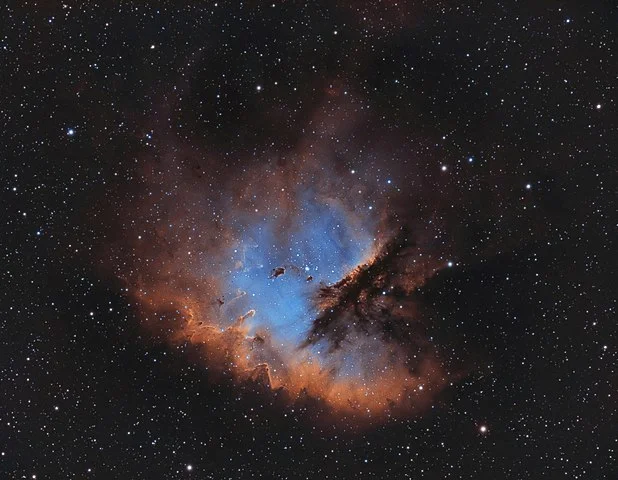
Pacman Nebula (NGC 281), image: Chuck Ayoub (CC BY-SA 4.0)
NGC 281 is associated with IC 1590 (Collinder 8), a young open cluster with an estimated age of 3.5 million years. The main sequence stars in the cluster are luminous blue stars of the spectral types O6.5 to B9.5. The spectral types of the pre-main sequence stars range from A8/9 to G8. The cluster has an apparent magnitude of 7.4. It contains 279 stars of magnitude 17 or brighter, including the multiple star system responsible for ionizing the gas in the nebula and making it glow. The O-type system lies near the centre of the nebula.
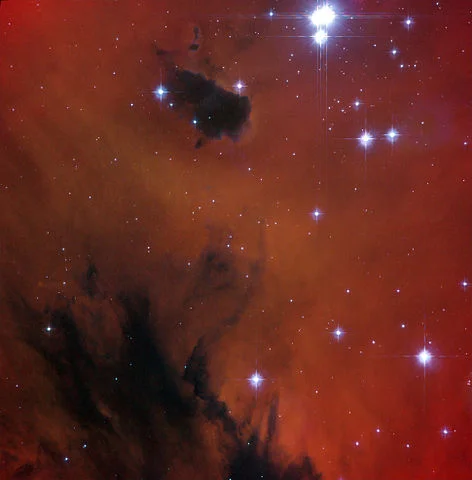
Astronomers have used the NASA/ESA Hubble Space Telescope to study the young open star cluster IC 1590, which is found within the star formation region NGC 281 — nicknamed the Pacman Nebula due to its resemblance to the famous arcade game character. This image only shows the central part of the nebula, where the brightest stars at the core of the cluster are found, with part of the Pacman’s hungry mouth visible as the dark region below. But Pacman isn’t gobbling up these stars. Instead, the nebula’s gas and dust are being used as raw ingredients to make new stars. However, the stars in IC 1590 are still plotting their escape from the Pacman Nebula, as open clusters are only loosely bound together and the grouping will eventually disperse within a few tens of millions of years. Image: ESA/Hubble & NASA
Catalogued as B 1 or β 1 (Burnham 1), HD 5005, HIP 4121 and ADS 719 ABCD, the star system is composed of an O-type star with an apparent magnitude of 7.8 and four companions. The companions are separated by 1.4 to 15.7 arcseconds from the primary. The physical separation between the main components of the system is between 4,000 and 26,000 astronomical units. The system was discovered by the American astronomer Sherburne Wesley Burnham (1838 – 1921). The Catalog of Components of Double & Multiple Stars (CCDM) lists five components with apparent magnitudes of 7.9, 9.9, 8.9, 9.4, and 12.1, while The Washington Visual Double Star Catalog lists as many as 17 components.
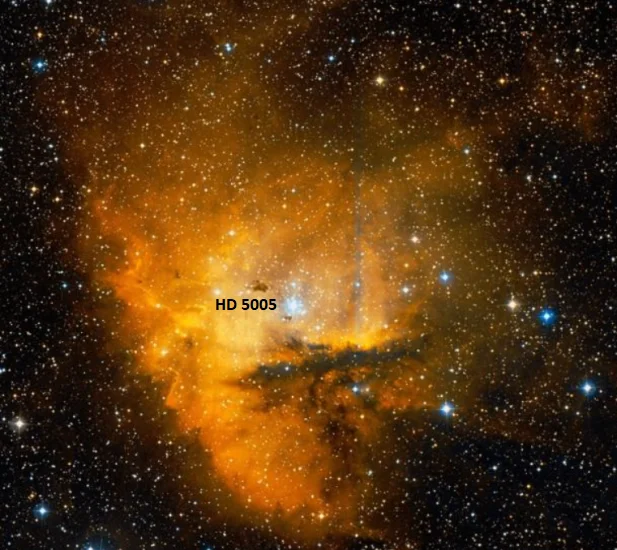
HD 5005 in the Pacman Nebula, image: Wikisky
Facts
NGC 281 was discovered by the American astronomer Edward Emerson Barnard in August 1883. It is one of the several well-known nebulae in the constellation Cassiopeia. The others are the Heart and Soul nebulae (IC 1805 and Westerhout 5) near the border with Perseus and the Bubble Nebula (NGC 7635) near Cepheus.
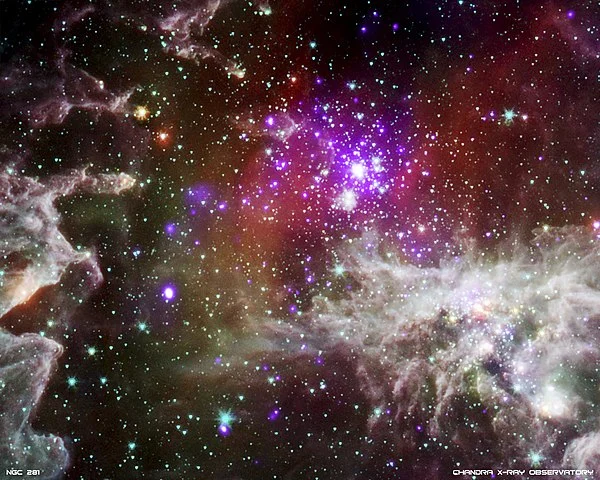
This composite image of NGC 281 contains X-ray data from Chandra (purple) with infrared observations from Spitzer (red, green, blue). The high-mass stars in NGC 281 drive many aspects of their galactic environment through powerful winds flowing from their surfaces and intense radiation that heats surrounding gas, “boiling it away” into interstellar space. This process results in the formation of large columns of gas and dust, as seen on the left side of the image. These structures likely contain newly forming stars. The eventual ends of massive stars as supernovas will also seed the galaxy with material and energy. X-ray: NASA/CXC/CfA/S.Wolk; IR: NASA/JPL/CfA/S.Wolk
The Pacman Nebula lies in the Perseus Spiral Arm of the Milky Way. Named after the constellation Perseus, in which it is seen, the Perseus Spiral Arm is one of our galaxy’s two major spiral arms. The other one is the Scutum-Centaurus arm. The Perseus Spiral Arm is believed to lie about 6,400 light years from the Sun and have a radius of about 10.7 kiloparsecs. It is over 60,000 light years long and about 1,000 light years wide.
Location
The Pacman Nebula is very easy to find because it lies near Cassiopeia’s W, one of the most distinctive asterisms in the northern sky. It appears just east (left) of Schedar (Alpha Cassiopeiae), the bottom right star of the “W,” and south of the binary star Achird (Eta Cassiopeiae). The nebula is easily visible in small telescopes.
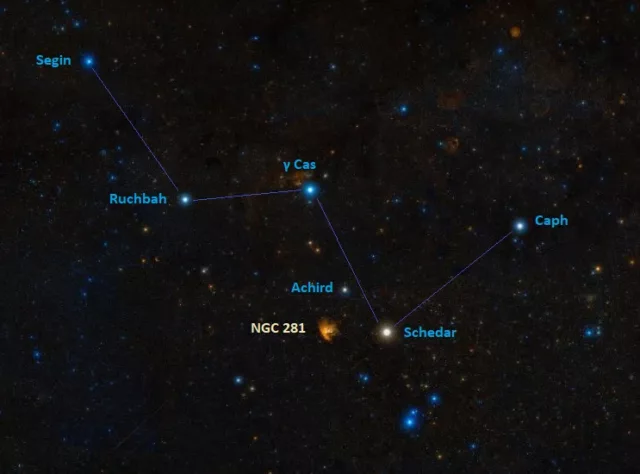
Pacman Nebula location, image: Wikisky
Pacman Nebula – NGC 281
| Constellation | Cassiopeia |
| Right ascension | 00h 52m 59.35s |
| Declination | +56° 37′ 18.8″ |
| Apparent size | 35 arcminutes |
| Radius | 48 light years |
| Distance | 9,200 light years (2820 parsecs) |
| Names and designations | Pacman Nebula, NGC 281, IC 11, Sharpless 184, Sh2-184, LBN 616, LBN 123.17-06.28 |